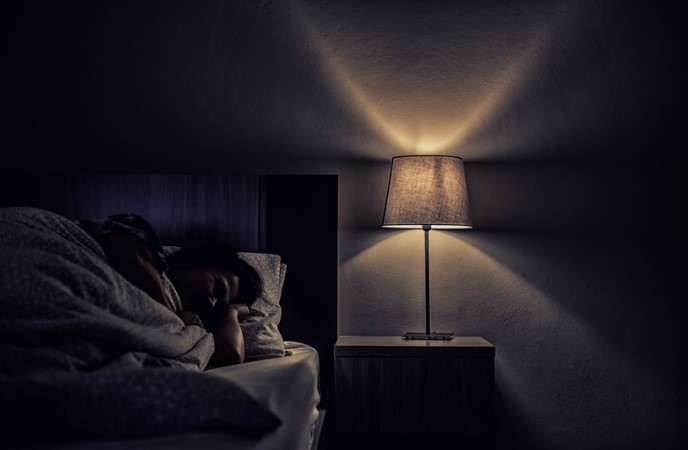Need Something More?
Check out our self-directed Spouse or Significant Other Wellbeing Course.

The recommended amount of sleep is 7-9 hours/night for healthy adults, although the optimal amount of sleep can vary depending on the person.1 The environment, daily habits, and pre-sleep routines can have an impact on amount and quality of sleep. See Skill Building below for information to support better sleep.
Life can get busy and it’s sometimes hard to find the time to get adequate sleep.
Many of the tips provided in the Skill Building section can still be useful during short-term periods with limited sleep to help you get the most out of the time you have.
If your sleep problems are associated with concerns such as stress, anxiety, or low mood, please click here for additional information about the Spouse Wellbeing Course (for spouses or significant others of PSP). This is a free, self-guided course for managing stress and various mental health concerns, as well as offering additional information and strategies to help improve sleep.
Getting enough sleep can be especially challenging for those who work rotating shifts, night shifts, or on-call shifts.
|

The following exercise is designed to help both partners identify good sleep habits and areas for improvement. Being aware of habits that benefit (or interfere with) sleep is an important step in supporting better sleep.
This exercise can be done individually or together. If completing this together, each of you can take a turn answering the questions on the slides below and discuss afterward. Sleep information and tips will be provided. (Note: some of the information and tips may need to be adjusted for those who work shift work.)
Below, there are 17 questions about your sleep habits. Answer the question on each slide by clicking either “yes” or “no” or skip a slide that is not applicable to you by pressing the right arrow at the bottom of the slide. Suggestions will appear regarding the benefits of certain habits, however, there are no right or wrong answers. Some suggestions may not be practical depending on your circumstances.
At the end of the activity, a summary is provided with your answers. You can print this summary by clicking on the print icon ![]() located on the bottom of the activity. Think about the questions that you answered “no” to, is there anything that you can change to improve your sleep habits? You can use the summary to set goals.
located on the bottom of the activity. Think about the questions that you answered “no” to, is there anything that you can change to improve your sleep habits? You can use the summary to set goals.
Check out our self-directed Spouse or Significant Other Wellbeing Course.
1Hirshkowitz, M., Whiton, K., Albert, S. M., Alessi, C., Bruni, O., DonCarlos, L., Hazen, N., Herman, J., Katz, E. S., Kheirandish-Gozal, L., Neubauer, D. N., O’Donnell, A. E., Ohayon, M., Peever, J., Rawding, R., Sachdeva, R. C., Setters, B., Vitiello, M. V., Ware, J. C., & Adams Hillard, P. J. (2015). National Sleep Foundation’s sleep time duration recommendations: Methodology and results summary. Sleep health, 1(1), 40–43. https://doi.org/10.1016/j.sleh.2014.12.010
Bootzin, R. R., & Epstein, D. R. (2011). Understanding and treating insomnia. Annual Review of Clinical Psychology, 7, 435-458. https://doi.org/10.1146/annurev.clinpsy.3.022806.091516
Dumont, M. (2019). Coping better with night work: Interactive web tutorial. http://formations.ceams-carsm.ca/night_work/
Lammers-van der Holst, H. M., Murphy, A. S., Wise, J. (2020). Sleep tips for shift workers in the time of pandemic. Southwest Journal of Pulmonary and Critical Care, 20(4), 128-130. https://www.ncbi.nlm.nih.gov/pmc/articles/PMC7189699/
Luyster, F. S., Strollo, P. J., Jr., Zee, P. C., & Walsh, J. K. (2012). Sleep: A health imperative. Sleep, 35(6), 727-734. https://doi.org/10.5665/sleep.1846
National Sleep Foundation. Retrieved from www.thensf.org
Richter, K., Adam, S., Geiss, L., Peter, L., & Niklewski, G. (2016). Two in a bed: The influence of couple sleeping and chronotypes on relationship and sleep. An overview. Chronobiology International, 33(10), 1464-1472. https://doi.org/10.1080/07420528.2016.1220388
Silberman, S. A. (2008). The insomnia workbook: A comprehensive guide to getting the sleep you need. New Harbinger Publications, Inc.
Sleep Foundation. Retrieved from: www.sleepfoundation.org
The National Institute for Occupational Safety and Health (2021). Napping, an important fatigue countermeasure. CDC Centers for Disease Control and Prevention. https://www.cdc.gov/niosh/emres/longhourstraining/napping.html
Troxel W. M. (2010). It’s more than sex: Exploring the dyadic nature of sleep and implications for health. Psychosomatic Medicine, 72(6), 578–586. https://doi.org/10.1097/PSY.0b013e3181de7ff8